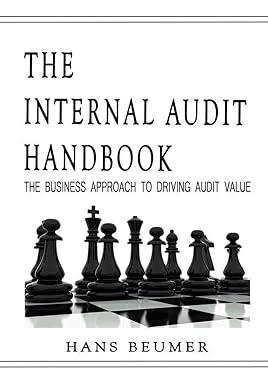Question
Read the memo and look at the data. Determine if the valuation makes sense. If it does not make sense, then use the data to
Read the memo and look at the data. Determine if the valuation makes sense. If it does not make sense, then use the data to come up with a better valuation. Send a memo to me explaining your rationale for your valuation along with the supporting calculations. You may work in groups of 2 or 3, and only person needs to submit the assignment. Make sure to include all team members on the memo.
To: E&Y External Audit Team
From: Keith Ice Cold Sellers, CFO, CBD, THC
Date: February 1, 2019
RE: Testing for Impairment of Goodwill for the First National Bank of Vail
This memo documents managements testing for impairment of the goodwill associated with the purchase of the First National Bank & Trust of Vail as of December 31, 2018. In 1999, Wells Fandango Bank purchased 100 percent of the outstanding shares of the First National Bank & Trust of Vail (hereafter referred to as FNBV), located in Vail, Colorado. Since that time, FNBV has been operated as an independent subsidiary and reporting unit of Wells Fandango.
As part of the preparation of the December 31, 2018 financial statements, and in accordance with the guidance of ASC 350-20-35-1, Subsequent Measurement of Goodwill, Wells Fandango management performed appropriate tests of impairment of goodwill on the reporting unit:
350-20-35-1: Goodwill shall not be amortized. Instead, goodwill shall be tested for impairment at a level of reporting referred to as a reporting unit.
Due to volatility in the economic outlook, as well as the market for bank stocks, management felt that qualitative factors made it necessary to perform the two-step goodwill impairment test as of December 31, 2018:
350-20-35-3: An entity may first assess qualitative factors, as described in paragraphs 350-20-35-3A through 35-3G, to determine whether it is necessary to perform the two-step goodwill impairment test discussed in paragraphs 350-20-35-4 through 35-19.
If determined to be necessary, the two-step impairment test shall be used to identify potential goodwill impairment and measure the amount of a goodwill impairment loss to be recognized (if any).
Step 1
350-20-35-4: The first step of the goodwill impairment test, used to identify potential impairment, compares the fair value of a reporting unit with its carrying amount, including goodwill.
350-20-35-2: Impairment is the condition that exists when the carrying amount of goodwill exceeds its implied fair value. The fair value of goodwill can be measured only as a residual and cannot be measured directly.
As laid out in the ASC, to test for impairment it is necessary to determine the fair value of the reporting unit as of December 31, 2018. The fair value is then compared to the carrying value of the reporting unit. In determining the fair value of the reporting unit, management followed the guidance found in ASC 350-20-35-24.
350-20-35-24: In estimating the fair value of a reporting unit, a valuation technique based on multiples of earnings or revenue or a similar performance measure may be used if that technique is consistent with the objective of measuring fair value.
Use of multiples of earnings or revenue in determining the fair value of a reporting unit may be appropriate, for example, when the fair value of an entity that has comparable operations and economic characteristics is observable and the relevant multiples of the comparable entity are known.
Conversely, use of multiples would not be appropriate in situations in which the operations or activities of an entity for which the multiples are known are not of a comparable nature, scope, or size as the reporting unit for which fair value is being estimated.
Clearly, a critical step in the determination of fair value is the identification of entities with comparable operations and economic characteristics. Fortunately, there are a large number of transactions of commercial banks in the U.S. and data on these transactions is generally available.
Using a subset of this data that included all transactions involving the sale of profitable banks, management determined that the reporting unit had a fair value of $330,099,000 as of December 31, 2018.[1] As of that date, the carrying value of the reporting unit was $125,000,000.
Since the fair value of the reporting unit exceeds the carrying value, the goodwill of the reporting unit is deemed to not be impaired. Moreover, the amount of fair value in excess of carrying value was significant, indicating that this conclusion would not be highly sensitive to changes in assumptions. A summary of our calculations follows:
| Average Price-to-Earnings Ratio for Sale of Similar Banks | 60.07 | ||||||
| FNB&T of Vail Net Income for 2014 | $5,495,000 | ||||||
| Indicated Fair Value of the Bank | $330,099,000 | ||||||
|
|
| ||||||
| Less: Carrying value of the Bank | $125,000,000 | ||||||
| Excess of Fair Value over Carrying Value |
| $205,099,000 | |||||
[1] FNBV is consistently profitable with above average returns on assets. Management deemed that unprofitable banks would not meet the criteria of comparable operations and economic characteristics and concluded that inclusion of transactions of banks with operating losses would skew the average price to earnings ratios. Thus, these transactions were omitted from the sample and calculations.
Step by Step Solution
There are 3 Steps involved in it
Step: 1

Get Instant Access to Expert-Tailored Solutions
See step-by-step solutions with expert insights and AI powered tools for academic success
Step: 2

Step: 3

Ace Your Homework with AI
Get the answers you need in no time with our AI-driven, step-by-step assistance
Get Started


